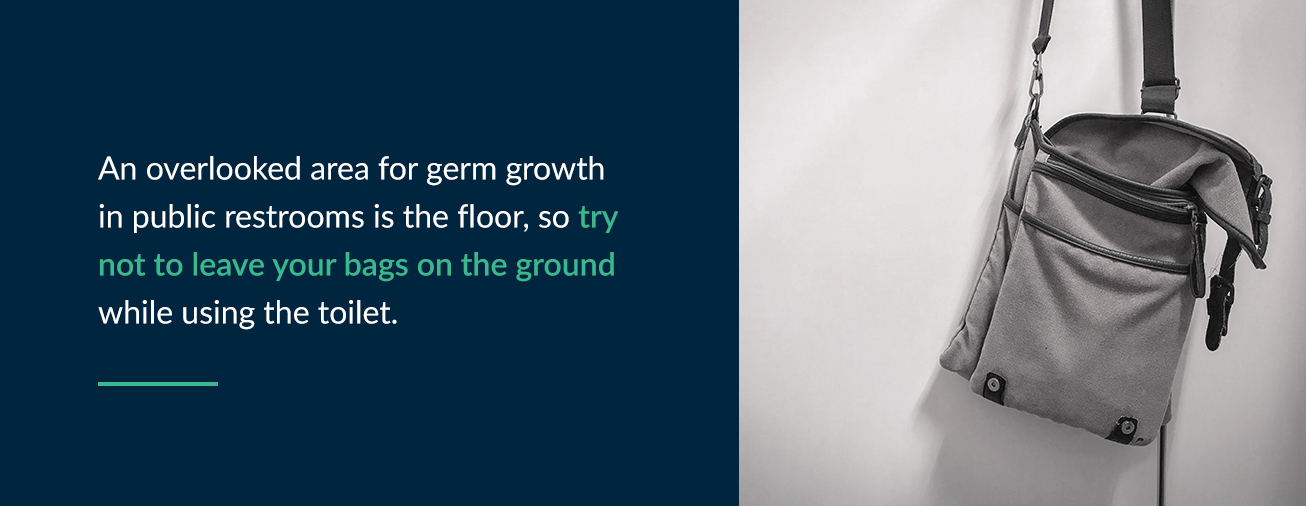How to Avoid Germs in Public Restrooms

If you’re a business owner hoping to keep your restroom clean, there’s plenty you can do to address germs. You can help prevent the spread of disease by encouraging your employees to avoid germs and by cleaning your public restrooms.
How to Limit Your Exposure
When using a public restroom, you may be more aware of all the places germs might be lurking. Fortunately, there are many things you can do to keep yourself safe while using a public toilet. As a business owner, you can communicate these tips to your staff to help them remain safe while using your facilities.
1. Avoid Touching Surfaces
Each surface in a public restroom is prone to different cultures of bacteria. According to a 2014 study, skin-associated bacteria grow on many high-touch surfaces, such as doors, stalls, faucets and soap dispensers. Gut-associated bacteria grow on toilet seats and handles.
Unfortunately, this bacteria is unavoidable. One of the main culprits is faucet handles. People touch the faucet with dirty hands and then again after washing, compromising their clean hands.
The best way to avoid contact with germs is to avoid touching surfaces. To prevent touching a dirty sink, leave the faucet on while you dry your hands, and turn the sink off using a paper towel. Avoid touching anything else in the bathroom after your hands are clean and dry. When paper towels aren’t available, you can use your clothing, such as sleeves or scarves, to open doors and use sinks. Even better, take advantage of flush, faucet and paper towel sensors to limit touching.
2. Avoid Touching Your Face
Bacteria and viruses often gain access to your body through your eyes, nose and mouth. Even when you’re careful about touching surfaces, it’s a good idea to avoid touching your face. Many people touch surfaces in the bathroom without even realizing it.
Avoiding touching your face can be more complicated than it sounds. Studies have shown that people rub their faces up to 23 times an hour. Of those face touches, 44% of them are in direct contact with the eyes, mouth or nose. Since public restrooms have higher concentrations of germs, it pays to remain extra vigilant during your bathroom break. If you can keep your hands away from your face for those few minutes and leave with clean hands, you can reduce your risk of infection.
3. Avoid Placing Items on the Floor
An overlooked area for germ growth in public restrooms is the floor, so try not to leave your bags on the ground while using the toilet. Most bathroom stalls have a convenient hook for coats and bags on the door. You can hang your belongings on these hooks while you use the restroom. If the bathroom is not too busy, consider leaving your items on the hook while you wash your hands.
4. Wash and Dry Your Hands Thoroughly
The easiest way to prevent the spread of germs in public restrooms is to wash your hands. According to the Centers for Disease Control and Protection, handwashing prevents the spread of infections. Washing your hands can prevent 30% of diarrhea-related illnesses and 20% of respiratory infections like colds.
Washing your hands thoroughly with soap and water for 20 seconds can kill viruses. Many viruses have lipid membranes holding them together. Soap molecules can bond with these lipid membranes, prying them apart. The soap traps fragments of the destroyed virus in tiny bubbles, allowing you to wash the virus away with water.
Keeping Public Restrooms Germ-Free
As a business owner, it’s your responsibility to ensure your bathrooms offer a clean, safe experience for guests. Keeping restrooms germ-free can leave guests with a better impression and help stop the spread of illnesses within the building. There are a few precautions you can take to help keep your bathrooms germ-free.
1. Stock Soap, Hand Sanitizer and Paper Towels
With handwashing on the rise, you might go through more soap, hand sanitizer and paper towels than usual. Have janitors or your cleaning crew check the soap and towel supply levels on every visit. If dispensers are empty on every cleaning, you should visit more often.
Installing hand sanitizer dispensers can also slow the spread of germs in your restroom. While less effective than handwashing, a sanitizer formula with 60% or higher alcohol content can kill pathogens. Your guests can also use hand sanitizer after touching the door handle.
2. Disinfect High-Touch Surfaces
Keeping public restrooms germ-free requires proper cleaning. Improper technique can be a major contributor to germ development. Here is the correct way to disinfect a bathroom:
- Use the right products and the right procedures: Many people spray aerosol cleaning solutions directly onto surfaces. This method is ineffective, and can also lead to respiratory issues for those who breathe it afterward. The best technique is to spray a cloth or paper towel and then wipe down the surfaces. You should also use the correct cleaning products for the surfaces in your bathroom.
- Ensure sufficient dwell time: The majority of disinfectants need a 10-minute dwell time to kill bacteria and viruses. If a janitor sprays and immediately wipes down the surfaces, they won’t be disinfected. It’s vital to read the directions and adjust people’s schedules to account for the amount of time it takes to clean the bathroom thoroughly.
- Disinfect often: Many people schedule restroom cleaning once a day. To combat germs, you need to clean surfaces several times a day, depending on the volume of guests. As soon as a bathroom is disinfected, it has the potential to become contaminated again.
- Avoid over-disinfecting: Using too many chemicals can cause respiratory health problems for visitors. Instead of disinfecting the floor or toilet bowls, which are rarely touched, focus on high-touch surfaces. The important places to clean are flush levers, partition and entrance handles, faucets, soap pumps and paper towel dispensers.
3. Design a Sanitary Bathroom
If you’re remodeling or building your public restroom, you can use smart designs that promote sanitation. When choosing your public bathroom partitions, select materials that are less likely to harbor bacteria. All the materials we use at One Point Partitions resist moisture and germs. A particularly safe option is solid plastic toilet partitions. Our thick, high-density polyethylene is both durable and waterproof, which makes for bacteria-resistant bathroom partitions.
A recent study found over 50% of washrooms have no shelves to place personal belongings during handwashing. By including an area for bags, you can encourage more people to wash their hands. The same study also found hand dryers are reservoirs for drug-resistant bacteria, so you may want to choose paper towels over automatic hand dryers.
You can also build more hands-free solutions into the bathroom. Innovative door handles allow people to open entry doors with their forearms. Sensors for flushers, faucets, soap pumps and paper towel dispensers allow your guests to go virtually hands-free in public restrooms.
4. Encourage Handwashing
Over 85% of washrooms provide no handwashing signage or reminders. In some environments, such as restaurants, the bathroom may be required to have signage telling employees to wash their hands. Even if you aren’t in a restaurant setting, you can improve cleanliness by asking staff to always wash their hands. You’ll help stop the spread of germs throughout your team and to your customers. A small sign that reminds guests to wash their hands can go a long way toward keeping your bathroom clean for all.
Shop High-Quality, Germ-Resistant Toilet Partitions
At One Point Partitions, we’re proud to offer ways to help you design sanitary bathrooms for your staff and customers. All our toilet partitions resist moisture for easy cleaning, and we’re happy to recommend options that will work best in your restroom.
We also offer complimentary bathroom design consultations. We will help you develop a layout that follows ADA guidelines and eases the cleaning process. By choosing partitions and a mounting style that allows for space underneath the doors, you make your floor more accessible to mop and allow cleaning chemicals to drain.
Contact us to learn more about our selection of stalls and urinal dividers.


